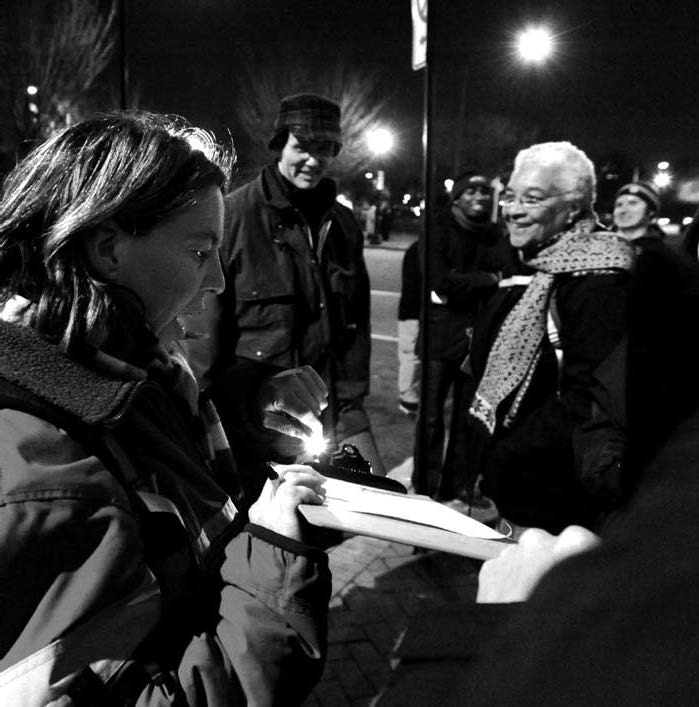Twelve.
That’s how many people a group of volunteers were able to find staying outside unsheltered, in an approximately 0.3 square mile section of the District in a single night, Wednesday, Jan. 25.
“I’ve only been out here for about three or four hours,” said Elijah, a middle aged man the group found around 11 p.m., passing time in an alleyway. It was his first night on the streets in six months, though he has been homeless on and off for approximately 20 years.
“Well, I just left a program that I was in, because my time was up.” Elija explained. “I was in the program because I was homeless, plus I was on parole… a lot of things. It’s like a reentry program.” “Reentry” programs are intended to foster the transition from incarceration back into the community.
This was first time in the local event’s 12-year history that the homeless count was being held on a “non-hypothermic” night when weather conditions were not considered threatening to human life, according to Cornell Chappelle, the Deputy Director of Operations for the Community Partnership for the Prevention of Homelessness (TCP).
TCP conducted the count, powered by over 200 volunteers and professional outreach workers, with the support of related organizations and agencies. The organization, founded in 1989, is a nonprofit that coordinates D.C.’s homeless services, everything from street outreach efforts and emergency shelters to transitional housing and permanent supportive housing for individuals and families. The entire spectrum of services is referred to as a continuum of care, a program model put in place in 1994 by the U.S. Department of Housing and Urban Development (HUD) to help move people out of homelessness.
Volunteer Josh Reiman, a resident of DC for more than two years, said he decided to help out with the count because he wanted to gain deeper insights into the plight of homeless people.
“I’ve always sympathized, but never had the chance to understand what their lives are like.”
Participants were divided into 24 groups assigned to specific sections of the city, and two roaming groups who moved across territories, in hopes of obtaining the most complete count possible. Similar efforts were mobilized in the city’s Maryland and Virginia suburbs and in jurisdictions across the country.
People experiencing homelessness were counted regardless of how they responded to the survey efforts. If a person was unwilling to participate in the survey, volunteers filled out a form including a general description of the person and his or her location.
One young man just stopped and stared straight ahead when Lissa Ramsepaul, a licensed social worker and a case manger for Miriam’s Kitchen, asked how he was doing that night.
Then the survey crew came upon a pile of tarps in a doorway, layered and wrapped tightly. At first, no one was sure if there was a person inside the pile. Then a man emerged.
Upon questioning, James, 30, seemed pleased to be counted.
“It’s my pleasure. It’s nice to be able to have a conversation with, y’know, people,” he said. “I appreciate it.”
“I’ve been homeless 10 years,” he said, “but I just recently started staying outside.” James said he left the shelter system because he no longer liked the attitudes of the longtime shelter-users.
“They think it’s cool to be in a shelter, so it’s hard for me to cope [there]. I’d rather stay out here.”
James said he spends his days seeking some kind of job.
“It’s smarter [than staying in a shelter],” he said. If he finds work, he said he hopes to earn enough to buy a cheap watch with an alarm to help him show up on time. If he needs money to get to the job, he said he will sell his food stamps to get a SmarTrip card for the bus. He will continue to sleep outside for awhile, to save money, he said. When asked about his biggest goal, he answered without hesitation.
“Career. Maybe school, then career. Not ‘job,’ but ‘CAREER.’”
He said he is really interested in nursing, but that if a nursing career does not work out he would be willing to work as a garbage man.
The homeless count must distill the facts from such dialogues into statistics that can be used to map the needs and burdens of the community. Yet the facts behind the statistics remain important.
James said he graduated from high school. Yet his education was disrupted many times.
“In foster care I moved around every six months of my life, so I’ve never been able to just focus on things like school. I graduated, but I graduated from a charter school – y’know, they don’t really give you a good education.”
Elija suffered from substance abuse. Yet he said he has been clean for 13 years. “I can’t even look at THAT – I’ve been over that,” he said.
Both men have been homeless for most of their adult lives, since they left foster care.
“This is the essence of putting work behind all of the talk, by measuring what we do and how we do it,” HUD Deputy Secretary Estelle Richman said, “We believe we can end homelessness in America.”
The full enumeration consists of this unsheltered count, as well as surveys within shelters on the day of, and follow up surveys at breakfast servings and drop-in centers the next day. The full count last year included 11,988 people, up 200 from 2010. This year’s numbers will be available in the spring,
James will be included. But he hopes to leave the world of homelessness behind.
“I try to not become homeless, y’know I’m surviving. I call myself surviving instead of homeless, because I do plan on getting out of this situation.”







